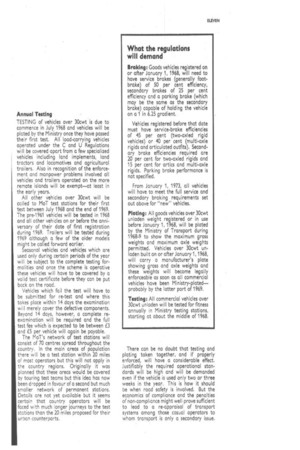What the regulations will demand
Page 79

If you've noticed an error in this article please click here to report it so we can fix it.
Braking: Goods vehicles registered on or after January 1, 1968, will need to have service brakes (generally footbrake) of 50 per cent efficiency, secondary brakes of 25 per cent efficiency and a parking brake (which may be the same as the secondary brake) capable of holding the vehicle on a 1 in 6,25 gradient, Vehicles registered before that date must have service-brake efficiencies of 45 per cent (two-axled rigid vehicles) or 40 per cent (multi-axle rigids and articulated outfits). Secondary brake efficiencies required are 20 per cent for two-axled rigids and 15 per cent for artics and multi-axle rigids. Parking brake performance is not specified.
From January 1, 1973, all vehicles will have to meet the full service and secondary braking requirements set out above for "new" vehicles, Plating: All goods vehicles over 30cwt unladen weight registered or in use before January 1, 1968, will be plated by the Ministry of Transport during 1968-9 to show the maximum gross weights and maximum axle weights permitted. Vehicles over 30cwt unladen built on or after January 1, 1968, will carry a manufacturer's plate showing grass and axle weights and these weights will become legally enforceable as soon as all commercial vehicles • have been Ministry-platedprobably by the latter part of 1969.
Testing: All commercial vehicles over 30cwt unladen will be tested for fitness annually in Ministry testing stations, starting at about the middle of 1968.












































































































































